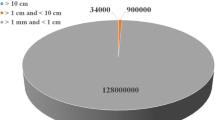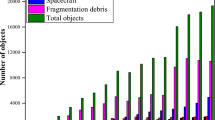Abstract
Micrometeoroids and Orbital Debris (MMOD) travelling at extremely high velocities in space are a threat to the structural integrity of spacecrafts in the Low Earth Orbit. Whipple shield, consisting of a Bumper and a Rear Wall, with a stand-off distance in between, is widely used to protect spacecrafts from hypervelocity MMOD impacts. In this paper, we present numerical simulations of a set of well-known hypervelocity impact (HVI) experiments on aluminium-based Whipple shields reported in the literature. These simulations are conducted using the three-dimensional Lagrangian Finite Element Method in ABAQUS/Explicit software. In six out of the seven tests reported in the literature, the Whipple shield failed due to a detached spall from the back surface of the Rear Wall, while in the seventh test, the spall was not detached. The present work successfully replicates and favourably compares the failure mechanisms observed in these Whipple shields to the corresponding experimental results. Various critical aspects of the Whipple shield’s failure mechanics and mechanisms are investigated. These include impact pressure on the projectile, Bumper and Rear Wall, Bumper hole diameter, temperature rise, and residual velocity of debris particles and spalled fragments. The predicted ballistic limit of the Whipple shield falls between 2.54 mm and 3.18 mm of Rear Wall thickness in excellent agreement with the experimental results reported in the literature. The present work provides valuable insights into Whipple shield performance. The developed methodology could be employed to optimize shield design through predictive simulations, thereby improving spacecraft protection.










Similar content being viewed by others
References
Limiting Future Collision Risk to Spacecraft: National Academies Press (2011). https://doi.org/10.17226/13244
Whipple, F.L.: Meteorites and space travel. Astron. J. 52, 131 (1947). https://doi.org/10.1086/106009
Zukas, J.A.: High Velocity Impact Dynamics. Wiley-Interscience, New York (1990)
Meng, S., Taddei, L., Lebaal, N., Roth, S.: Advances in ballistic penetrating impact simulations on thin structures using smooth particles hydrodynamics: a state of the art. Thin-Walled Struct. 159, 107206 (2021). https://doi.org/10.1016/j.tws.2020.107206
Wen, K., Chen, X.-W., Lu, Y.-g: Research and development on hypervelocity impact protection using whipple shield: an overview. Defence Technol. 17(6), 1864–1886 (2021). https://doi.org/10.1016/j.dt.2020.11.005
Doolan, C.J.: A two-stage light gas gun for the study of high speed impact in propellants. Technical report (2001). https://api.semanticscholar.org/CorpusID:108181892
Verma, P.N., Dhote, K.D.: Characterising primary fragment in debris cloud formed by hypervelocity impact of spherical stainless steel projectile on thin steel plate. Int. J. Impact Eng 120, 118–125 (2018). https://doi.org/10.1016/j.ijimpeng.2018.05.003
Seisson, G., Hébert, D., Bertron, I., Chevalier, J.-M., Hallo, L., Lescoute, E., Videau, L., Combis, P., Guillet, F., Boustie, M., Berthe, L.: Dynamic cratering of graphite: experimental results and simulations. Int. J. Impact Eng. 63, 18–28 (2014). https://doi.org/10.1016/j.ijimpeng.2013.08.001
Christiansen, E.L., Kerr, J.H.: Projectile shape effects on shielding performance at 7 km/s and 11 km/s. Int. J. Impact Eng. 20(1), 165–172 (1997). https://doi.org/10.1016/S0734-743X(97)87490-8. (Hypervelocity Impact Proceedings of the 1996 Symposium)
Schonberg, W.P., Williamsen, J.E.: RCS-based ballistic limit curves for non-spherical projectiles impacting dual-wall spacecraft systems. Int. J. Impact Eng. 33(1), 763–770 (2006). https://doi.org/10.1016/j.ijimpeng.2006.09.076. (Hypervelocity Impact Proceedings of the 2005 Symposium)
Liu, M.B., Liu, G.R.: Smoothed particle hydrodynamics (SPH): an overview and recent developments. Arch. Comput. Methods Eng. 17(1), 25–76 (2010). https://doi.org/10.1007/s11831-010-9040-7
Zhang, X.-T., Li, X.-G., Liu, T., Jia, G.-h: Element fracture technique for hypervelocity impact simulation. Adv. Space Res. 55(9), 2293–2304 (2015). https://doi.org/10.1016/j.asr.2015.01.040
Horner, J.K.: A comparison of ballistic limit with adaptive-mesh Eulerian hydrocode predictions of one- and two-plate aluminum shielding protection against millimeter-sized Fe–Ni space debris. Int. J. Impact Eng. 35(12), 1602–1605 (2008). https://doi.org/10.1016/j.ijimpeng.2008.07.039. (Hypervelocity Impact Proceedings of the 2007 Symposium)
Pezzica, G., Destefanis, R., Faraud, M.: Numerical simulation of orbital debris impact on spacecraft. WIT Trans. Built Environ. 25, 10 (1970)
Katayama, M., Kibe, S., Toda, S.: A numerical simulation method and its validation for debris impact against the Whipple bumper shield. Int. J. Impact Eng. 17(4–6), 465–476 (1995). https://doi.org/10.1016/0734-743x(95)99871-n
Katayama, M., Toda, S., Kibe, S.: Numerical simulation of space debris impacts on the Whipple shield. Acta Astronaut. 40(12), 859–869 (1997). https://doi.org/10.1016/s0094-5765(97)00128-8
Fahrenthold, E.P.: Oblique hypervelocity impact simulation for Whipple shield-protected structures. Int. J. Impact Eng. 17(1–3), 291–302 (1995). https://doi.org/10.1016/0734-743x(95)99855-l
Fahrenthold, E.P., Yew, C.H.: Hydrocode simulation of hypervelocity impact fragmentation. Int. J. Impact Eng. 17(1–3), 303–310 (1995). https://doi.org/10.1016/0734-743x(95)99856-m
Kerr, J.H., Fahrenthold, E.P.: Three dimensional hypervelocity impact simulation for orbital debris shield design. Int. J. Impact Eng. 20(6–10), 479–489 (1997). https://doi.org/10.1016/s0734-743x(97)87436-2
Bashurov, V.V., Bebenin, G.V., Belov, G.V., Bukharev, Y.N., Zhukov, V.I., Ioilev, A.G., Lapichev, N.V., Mikhailov, A.L., Smirnov, G.S., Fateev, Y.A., Schlyapnikov, G.P.: Experimental modelling and numerical simulation of high- and hypervelocity space debris impact to spacecraft shield protection. Int. J. Impact Eng. 20(1–5), 69–78 (1997). https://doi.org/10.1016/s0734-743x(97)87480-5
Faraud, M., Destefanis, R., Palmieri, D., Marchetti, M.: SPH simulations of debris impacts using two different computer codes. Int. J. Impact Eng. 23(1), 249–260 (1999). https://doi.org/10.1016/s0734-743x(99)00077-9
Fahrenthold, E.P., Horban, B.A.: A hybrid particle-finite element method for hypervelocity impact simulation. Int. J. Impact Eng. 23(1), 237–248 (1999). https://doi.org/10.1016/s0734-743x(99)00076-7
Rabb, R.J., Fahrenthold, E.P.: Numerical simulation of oblique impact on orbital debris shielding. Int. J. Impact Eng. 23(1), 735–744 (1999). https://doi.org/10.1016/s0734-743x(99)00118-9
Beissel, S.R., Gerlach, C.A., Johnson, G.R.: Hypervelocity impact computations with finite elements and meshfree particles. Int. J. Impact Eng. 33(1–12), 80–90 (2006). https://doi.org/10.1016/j.ijimpeng.2006.09.047
Silnikov, M.V., Guk, I.V., Nechunaev, A.F., Smirnov, N.N.: Numerical simulation of hypervelocity impact problem for spacecraft shielding elements. Acta Astronaut. 150, 56–62 (2018). https://doi.org/10.1016/j.actaastro.2017.08.030
Ryan, S., Christiansen, E.L.: Hypervelocity impact testing of advanced materials and structures for micrometeoroid and orbital debris shielding. Acta Astronaut. 83, 216–231 (2013). https://doi.org/10.1016/j.actaastro.2012.09.012
Aluminum Alloy, Tubing, Hydraulic (6062 T6). SAE International. https://doi.org/10.4271/ams4093a
Rao, C.L., Narayanamurthy, V., Simha, K.: Applied Impact Mechanics. Wiley, New York (2016)
Lindholm, U.S., Johnson, G.R.: Strain-rate effects in metals at large shear strains. In: Material Behavior Under High Stress and Ultrahigh Loading Rates, pp. 61–79 (1983). https://doi.org/10.1007/978-1-4613-3787-4_4
Jog, C.S.: Continuum mechanics: Volume 1: Foundations and applications of mechanics. Cambridge University Press, Cambridge (2015)
ABAQUS: Version 6.14. Abaqus/Standard User’s Manual, DASSAULT SYSTEMES, Simulia Inc. (2014)
Hiermaier, S.: Structures Under Crash and Impact. Springer, New York (2008). https://doi.org/10.1007/978-0-387-73863-5
Johnson, G.R.: A constitutive model and data for materials subjected to large strains, high strain rates, and high temperatures. In: Proceedings of the 7th International Symposium on Ballistics, pp. 541–547 (1983)
Systèmes, D.: Simulation of the ballistic perforation of aluminum plates with abaqus/explicit, abaqus technology brief. DASSAULT SYSTÈMES, Waltham, MA (2012)
Leseur, D.: Experimental investigations of material models for Ti–6A1–4V and 2024-t3. Technical Report (1999). https://doi.org/10.2172/11977
Abdelal, G.F., Georgiou, G., Cooper, J., Murphy, A., Robotham, A., Lunt, P.: Investigation of aircraft panel deformations during riveting process. In: 4th Aircraft Structural Design Conference (2014)
Steinberg, D., et al.: Equation of state and strength properties of selected materials. Lawrence Livermore National Laboratory Livermore (1996)
Kay, G.: Failure modeling of titanium-6al-4v and 2024-t3 aluminum with the Johnson–Cook material model (2002). https://doi.org/10.2172/15006359
Salvador, M.D.M.: Hypervelocity impact of spherical aluminum 2017-t4 projectiles on aluminum 6061-t6 multi-layered sheets. Mississippi State University (2017)
Meyers, M.A.: Dynamic Behavior of Materials. Wiley, New York (1994)
Antoun, T., Seaman, L., Curran, D.R., Kanel, G.I., Razorenov, S.V., Utkin, A.V.: Spall Fracture. Springer, Berlin (2003)
Dorogoy, A., Rittel, D., Weihs, D.: Effect of target velocity on damage patterns in hypervelocity glancing collisions. Int. J. Impact Eng. 144, 103664 (2020). https://doi.org/10.1016/j.ijimpeng.2020.103664
Vigil, M.G.: Projectile impact hugoniot parameters for selected materials. Technical Report (1989). https://doi.org/10.2172/5658829
Hatami, H., Hosseini, M., Yasuri, A.K.: Perforation of thin aluminum targets under hypervelocity impact of aluminum spherical projectiles. Mater. Eval. 77(3), 411–422 (2019)
Christiansen, E.L., Kerr, J.H.: Ballistic limit equations for spacecraft shielding. Int. J. Impact Eng. 26(1–10), 93–104 (2001). https://doi.org/10.1016/s0734-743x(01)00070-7
Piekutowski, A.J., Poormon, K.L., Christiansen, E.L., Davis, B.A.: Performance of Whipple shields at impact velocities above 9km/s. Int. J. Impact Eng. 38(6), 495–503 (2011). https://doi.org/10.1016/j.ijimpeng.2010.10.021
Rotz, J.: Evaluation of tornado missile impact effects on structures. In: Proceedings of a Symposium on Tornadoes, Assessment of Knowledge and Implications for Man. Texas Technical University, Lubbock, TX (1976)
Nuttall, A., Close, S.: A thermodynamic analysis of hypervelocity impacts on metals. Int. J. Impact Eng. 144, 103645 (2020). https://doi.org/10.1016/j.ijimpeng.2020.103645
Acknowledgements
The authors would like to acknowledge the financial support provided by ISRO-IITB Space Technology Cell for this research through a sponsored project with code RD/0119-ISROC00-010. The authors would like to thank Dr. Rajeev Chaturvedi of ISRO for bringing Reference [26] to their attention and for useful discussions.
Author information
Authors and Affiliations
Corresponding author
Ethics declarations
Conflict of interest
No conflict of interest.
Additional information
Publisher's Note
Springer Nature remains neutral with regard to jurisdictional claims in published maps and institutional affiliations.
Rights and permissions
Springer Nature or its licensor (e.g. a society or other partner) holds exclusive rights to this article under a publishing agreement with the author(s) or other rightsholder(s); author self-archiving of the accepted manuscript version of this article is solely governed by the terms of such publishing agreement and applicable law.
About this article
Cite this article
Kamble, A., Tandaiya, P. Mechanisms of failure of aluminium-based Whipple shields under hypervelocity impact: insights from continuum simulations. Acta Mech (2024). https://doi.org/10.1007/s00707-024-03898-y
Received:
Revised:
Accepted:
Published:
DOI: https://doi.org/10.1007/s00707-024-03898-y




